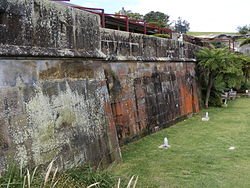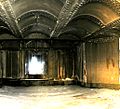
Port Jackson, consisting of the waters of Sydney Harbour, Middle Harbour, North Harbour and the Lane Cove and Parramatta Rivers, is the ria or natural harbour of Sydney, New South Wales, Australia. The harbour is an inlet of the Tasman Sea. It is the location of the Sydney Opera House and Sydney Harbour Bridge. The location of the first European settlement and colony on the Australian mainland, Port Jackson has continued to play a key role in the history and development of Sydney.

The Western Heights of Dover are one of the most impressive fortifications in Britain. They comprise a series of forts, strong points and ditches, designed to protect the country from invasion. They were created in the 18th and 19th centuries to augment the existing defences and protect the key port of Dover from both seaward and landward attack; by the start of the 20th century Dover Western Heights was collectively reputed to be the 'strongest and most elaborate' fortification in the country. The Army finally withdrew from the Heights in 1956–61; they are now a local nature reserve.
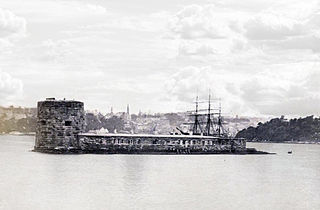
Fort Denison, part of the Sydney Harbour National Park, is a protected national park that is a heritage-listed former penal site and defensive facility occupying a small island located north-east of the Royal Botanic Garden and approximately 1 kilometre (0.62 mi) east of the Opera House in Sydney Harbour, New South Wales, Australia. The island is also known as Mattewanye or Muddawahnyuh in the Eora language, and as Pinchgut Island.

Georges Heights is an urban locality in the suburb of Mosman, adjoining Sydney, in the state of New South Wales, Australia. Georges Heights is located in the local government area of the Municipality of Mosman and is part of the Lower North Shore.

The Sydney Heads are a series of headlands that form the 2 km (1.2 mi) wide entrance to Sydney Harbour in Sydney, New South Wales, Australia. North Head and Quarantine Head are to the north; South Head and Dunbar Head are to the south; and Middle Head, Georges Head, and Chowder Head are to the west and within the harbour. The Heads are contained within the Sydney Harbour National Park.

Tourism in Sydney, Australia forms an important part of the city's economy. The city received 12 million domestic visitors and 4.1 million international visitors in year ending June 2019. The most famous attractions include the Sydney Opera House, and the Sydney Harbour Bridge. Other attractions include the Sydney Mardi Gras, Royal Botanical Gardens, Luna Park, the beaches and Sydney Tower.

Bare Island is a heritage-listed islet located in the Eastern Suburbs of Sydney, in La Perouse in the City of Randwick local government area in the state of New South Wales, in eastern Australia. The islet is located about 16 kilometres (9.9 mi) south east of the Sydney central business district, within Botany Bay, close to the bay's northern headland. Containing former fortification facilities, Bare Island was a former war veterans' home and museum and is now a historic site that was added to the New South Wales State Heritage Register on 2 April 1999 and is significant as an almost completely intact example of late nineteenth century coastal defence technology. It was designed by Sir Peter Scratchley, Gustave Morell and James Barnet and built from 1881 to 1889 by John McLeod on behalf of the NSW Department of Public Works.
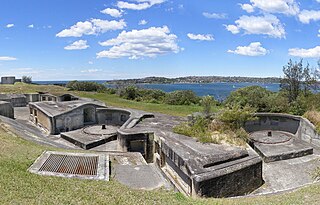
Sydney Harbour was protected by coastal batteries and other fixed defences from the early 19th century until the 1960s. These defences were constructed to protect the Australian city of Sydney from attack by enemy warships and submarines.

The Middle Head Fortifications is a heritage-listed former defence establishment and military fortifications and now public space located at Middle Head Road, Middle Head, Mosman in the Mosman Council local government area of New South Wales, Australia. It is also known as the Middle Head Military Fortifications or The Old Fort. The fortifications consist of the Outer Middle Head Battery located at the end of Old Fort Road, the Inner Middle Head Battery located at the end of Governors Road, and the Obelisk batteries reached by a path from the corner of Middle Head Road and Chowder Bay Road. The fortifications at Middle Head formed part of Sydney Harbour's defences. The property is owned by the Department of Planning and Environment. It was added to the New South Wales State Heritage Register on 2 April 1999.

The Lower Georges Heights Commanding Position is located in the urban locality of Georges Heights in the suburb of Mosman, on the shores of Port Jackson, Sydney, New South Wales, Australia. The Lower Georges Heights Commanding Position was constructed and designed to stop enemy ships from entering into Sydney Harbour, and worked in conjunction with several others forts located within close proximity.
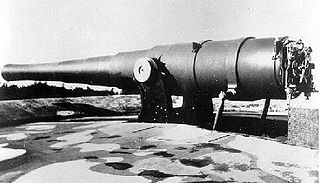
The Ben Buckler Gun Battery is a heritage-listed fortified former gun emplacement and military installation of the late-Victorian period and now public open space located in the North Bondi locality of Ben Buckler, in the Sydney, Australia. The gun battery was designed by NSW Colonial Government and built during 1893. It is also known as Ben Buckler Gun Battery 1893, 9.2 Disappearing Gun and Bondi Battery. The property is owned by Waverley Municipal Council. It was added to the New South Wales State Heritage Register on 15 December 2006.

The Steele Point Battery is a small fort, on the shores of Port Jackson in the eastern Sydney suburb of Vaucluse, Australia.

The Bradleys Head Fortification Complex is a heritage-listed former mast and defensive battery and military fortification and now war memorial and recreational area located at Bradleys Head Road within the Sydney Harbour National Park in Mosman in the Mosman Council local government area of New South Wales, Australia. It was designed by Government engineers and built from 1840 to 1934. It is also known as Bradleys Head Forts and HMAS Sydney 1 Mast and Associated Memorials. The property is owned by the NSW Office of Environment and Heritage, an agency of the Government of New South Wales. It was added to the New South Wales State Heritage Register on 30 August 2010.

The Dawes Point Battery remains is a heritage-listed former artillery fortification and now visitor attraction located adjacent to the southern pylon of the Sydney Harbour Bridge at Hickson Road in inner city Sydney, on the boundary between Dawes Point and The Rocks in the City of Sydney local government area of New South Wales, Australia. It was built and modified from 1791 to 1925 by Lieutenant William Dawes, Robert Ross, Francis Greenway, and George Barney. The property is owned by Property NSW, an agency of the Government of New South Wales. It was added to the New South Wales State Heritage Register on 10 May 2002.

The Signal Hill Battery was constructed in 1892/93 at Watsons Bay and is adjacent to the Signal Hill Lighthouse on Old South Head Road.

Mosman is a suburb on the Lower North Shore region of Sydney, in the state of New South Wales, Australia. Mosman is located 8 kilometres north-east of the Sydney central business district and is the administrative centre for the local government area of the Municipality of Mosman.

Fort Lytton is a heritage-listed 19th century coastal fort in the suburb of Lytton in Brisbane, Queensland, Australia. The name “Fort Lytton” is also used to describe the 1 square mile (2.6 km2) military base that surrounded the fort. Fort Lytton was built in 1880–1882, and operated until 1965. The historic fort is now contained in Fort Lytton National Park. The park is open to the public on most Sundays and public holidays. Guided tours are provided by Fort Lytton Historical Association, a non-profit volunteer organisation.

Kissing Point Fortification is a heritage-listed fortification at 38-40 Howitt Street, North Ward, City of Townsville, Queensland, Australia. It was designed by Peter Scratchley and Major Edward Druitt and built from 1891 by A McMillan and then from 1939 to 1941. It is also known as Jezzine Barracks. It was added to the Queensland Heritage Register on 5 February 2010.

The Shepherds Hill military installations is a New South Wales state heritage-listed site, consisting of a former military gun battery emplacement, observation post and gunner's cottage at The Terrace in Newcastle, New South Wales, Australia. It was built from 1890 to 1940. It is also known as Shepherds Hill Defence Group Military Installations, Observation Post and Gun Placement and Shepherds Hill Battery. It was added to the New South Wales State Heritage Register on 2 July 2010.
Green Hill Fort is a heritage-listed fortification at Chester Street, Thursday Island in the Torres Strait, Queensland, Australia. The fort is important in Australian military history as a strategic coastal defence installation in the period of transition from British to Australian responsibility for defence. The 1885 confrontation between Britain and Russia, which almost resulted in open conflict, galvanised the Australian colonies to jointly fund construction of the fortifications, and these represent an important and uncommon instance of pre-Federation Colonial cooperation on defence in the "national" interest. The fort was added to the Australian Commonwealth Heritage List on 28 May 2008.
